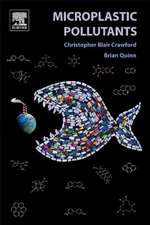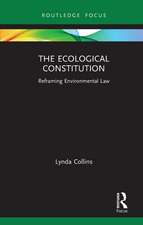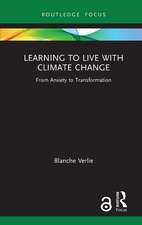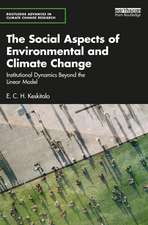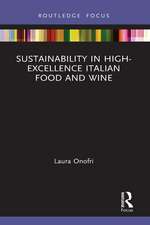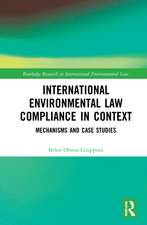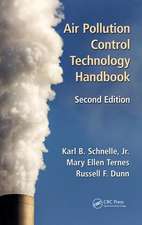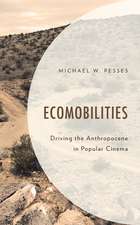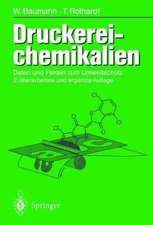Environmental Isotopes in Biodegradation and Bioremediation
Editat de C. Marjorie Aelion, Patrick Höhener, Daniel Hunkeler, Ramon Aravenaen Limba Engleză Hardback – 4 noi 2009
Environmental Isotopes in Biodegradation and Bioremediation comprehensively covers established and emerging isotope methods for environmental applications, focusing on biodegradation and bioremediation. This book is an invaluable tool for researchers, practitioners, and regulators who require an extensive understanding of the application of isotope methods to natural compounds and environmental contaminants. It addresses questions including:
What amount of a compound comes from anthropogenic release?
Do the chemicals involved undergo degradation in the environment?
Do they persist and accumulate?
This book is divided into four sections:
Isotope Fundamentals covers important background and theoretical information needed to understand later chapters
Isotopes and Microbial Processes discusses the application of isotopes to different environmental redox conditions that dictate the predominant microbial processes that will occur
Isotopes in Field Applications describes the transformation of anthropogenic pollutants and the application of isotope tools to field sites
Isotope Emerging Areas addresses the use of compounds labeled with stable isotopes, including stable isotope probing and the use of radiocarbon at natural abundance and novel stable isotopes
This reference details how isotope tools can be used to gain insight into the origin and fate of natural compounds and contaminants in the environment. Integrating theoretical and practical knowledge, the authors examine the principles of isotope tools and then present an extensive overview of key environmental processes that can be investigated with isotope methods. They also discuss analytical and data evaluation procedures, addressing established and emerging applications. To illustrate concepts and methodology, the authors use a wide range of case studies and recent field and laboratory research from various disciplines currently employing these methods. This book is a valuable tool for expanding the application of both stable isotopes and radioisotopes into untapped areas.
Preț: 1121.01 lei
Preț vechi: 1367.09 lei
-18% Nou
Puncte Express: 1682
Preț estimativ în valută:
214.51€ • 229.38$ • 178.85£
214.51€ • 229.38$ • 178.85£
Carte tipărită la comandă
Livrare economică 18 aprilie-02 mai
Preluare comenzi: 021 569.72.76
Specificații
ISBN-13: 9781566706612
ISBN-10: 1566706610
Pagini: 464
Ilustrații: 98 b/w images, 31 tables and Less than 200
Dimensiuni: 156 x 234 x 30 mm
Greutate: 0.79 kg
Ediția:1
Editura: CRC Press
Colecția CRC Press
ISBN-10: 1566706610
Pagini: 464
Ilustrații: 98 b/w images, 31 tables and Less than 200
Dimensiuni: 156 x 234 x 30 mm
Greutate: 0.79 kg
Ediția:1
Editura: CRC Press
Colecția CRC Press
Public țintă
ProfessionalCuprins
Isotope Fundamentals. Fundamentals of Environmental Isotopes and Their Use in Biodegradation. Analysis of Stable Isotopes. Principles and Mechanisms of Isotope Fractionation. Isotope Fractionation During Transformation Processes. Isotopes and Microbial Processes. Isotopes and Aerobic Degradation. Isotopes and Methane Cycling. Isotopes and Processes in the Nitrogen and Sulfur Cycles. Isotopes in Field Applications.
Investigating the Origin and Fate of Organic Contaminants in Groundwater using Stable Isotope Analysis. Stable Isotope Fractionation of Gases and Contaminant Vapors in the Unsaturated Zone. Isotope Emerging Areas. Isotopic Labeling in Environmental and Biodegradation Studies. Combined Use of Radiocarbon and Stable Carbon Isotopes in Environmental and Degradation Studies. Nontraditional Stable Isotopes in Environmental Sciences. Index.
Investigating the Origin and Fate of Organic Contaminants in Groundwater using Stable Isotope Analysis. Stable Isotope Fractionation of Gases and Contaminant Vapors in the Unsaturated Zone. Isotope Emerging Areas. Isotopic Labeling in Environmental and Biodegradation Studies. Combined Use of Radiocarbon and Stable Carbon Isotopes in Environmental and Degradation Studies. Nontraditional Stable Isotopes in Environmental Sciences. Index.
Notă biografică
C. Marjorie Aelion is dean of the School of Public Health and Health Sciences at the University of Massachusetts, Amherst. She worked for the U.S. Geological Survey, Water Resources Division, as a hydrologist for three years before beginning her academic career at the University of South Carolina in Columbia as an assistant professor, associate professor, professor, and associate dean for research. Her research interests lie in the assessment of biodegradation and bioremediation of organic contaminants, and associations between soil metals and negative childhood health outcomes.
Ramon Aravena is a research professor in the Department of Earth and Environmental Sciences at the University of Waterloo, Ontario, Canada. Dr. Aravena’s research has focused on the application of environmental isotopes in hydrology, geochemistry, and quaternary geology. He has been involved in numerous groundwater studies in Latin America, Canada, the United States, and Europe related to evaluation of groundwater resources and groundwater contamination.
Patrick Höhener is a professor in hydrogeochemistry at the University of Provence, Marseille. He obtained a Ph.D in environmental sciences in 1990 from the Swiss Federal Institute of Technology, where he later had a position as lecturer at Zurich and Lausanne. His research interests lie in the management and remediation of soils and aquifers contaminated with organic chemicals.
Daniel Hunkeler is professor for groundwater quality at the Centre for Hydrogeology of the University of Neuchâtel, Switzerland and adjunct professor at the University of Waterloo, Canada. He obtained a Ph.D from the Swiss Federal Institute for Technology, Zürich. His research focuses on the development of stable isotope methods and their application to gain insight into the contaminant behavior at the field scale.
Ramon Aravena is a research professor in the Department of Earth and Environmental Sciences at the University of Waterloo, Ontario, Canada. Dr. Aravena’s research has focused on the application of environmental isotopes in hydrology, geochemistry, and quaternary geology. He has been involved in numerous groundwater studies in Latin America, Canada, the United States, and Europe related to evaluation of groundwater resources and groundwater contamination.
Patrick Höhener is a professor in hydrogeochemistry at the University of Provence, Marseille. He obtained a Ph.D in environmental sciences in 1990 from the Swiss Federal Institute of Technology, where he later had a position as lecturer at Zurich and Lausanne. His research interests lie in the management and remediation of soils and aquifers contaminated with organic chemicals.
Daniel Hunkeler is professor for groundwater quality at the Centre for Hydrogeology of the University of Neuchâtel, Switzerland and adjunct professor at the University of Waterloo, Canada. He obtained a Ph.D from the Swiss Federal Institute for Technology, Zürich. His research focuses on the development of stable isotope methods and their application to gain insight into the contaminant behavior at the field scale.
Descriere
The use of stable isotopes and naturally occurring radioisotopes continues to gain interest as a way to evaluate the origin and fate of naturally occurring substances and contaminants in the environment. This book covers basic principles of isotope methods, details the major environmental processes to which isotope methods can be applied, and provides comprehensive information on analytical and data evaluation procedures. Using a wide range of case studies from recent field applications, and laboratory research, the authors illustrate the concepts and methodologies of stable isotope and radioisotope tools. The book relates the method to various disciplines currently employing these approaches.

